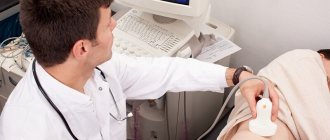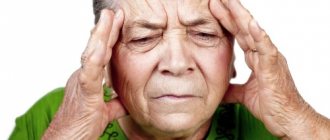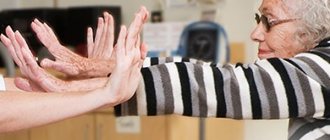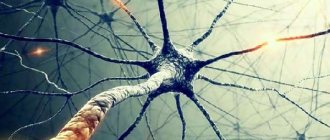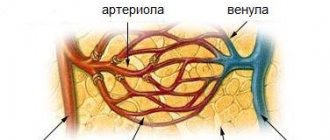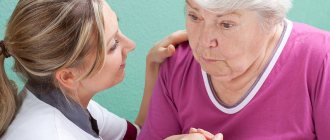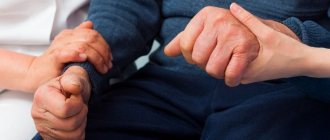This disease has not been studied because it is associated with such a complex and not yet fully understood nervous system.
Scientists have not yet fully discovered the pathogenesis of the disease, and the exact preventive measures are not known.
Parkinson's disease according to ICD-10 and its features
In the classifier, the ICD code for Parkinson's disease is designated as Class VI G20.
This class is assigned to all diseases of the nervous system, that is, the disease is based on neurological problems. To be more precise, the disorder manifests itself due to the primary damage to a group of neurons whose main function is the production of dopamine. It is generally accepted that this hormone is responsible for the formation of feelings of love, affection, and other positive emotions, but in fact it also plays an extremely important role in human cognitive activity, and it is this aspect that suffers the most in Parkinson’s disease. A person becomes inert, his mental processes slow down significantly, and perseverations appear in consciousness and speech.
The letter G in ICD-10 is assigned to extrapyramidal and other movement disorders. Parkinson's disease according to ICD-10 causes motor disorders specifically in the extrapyramidal structures of the brain. Its main symptoms are:
- Muscle rigidity - they become as if “hard”, difficult to control.
- Limitation of movements - the little activity that remains in the patient has a very slow pace.
- Involuntary movements in the form of hand tremors.
- Unstable position of the body, and we are talking not only about the limbs, the patient’s head is also positioned incorrectly in relation to them.
Important: All of the above symptoms do not appear all at once, but gradually, constantly worsening the patient’s life. That is why the disease in ICD-10 is classified as degenerative.
Parkinson's disease code according to ICD 10 also contains a digital designation - 20. This makes it possible to distinguish this disorder from many others with similar symptoms and causes, but still having its own characteristics.
Other codes in the ICD-10 classification
The symptoms of Parkinson's disease are so specific that over time they have a single definition - “parkinsonism”. Although most often a complex of problems indicates the development of Parkinson's disease, there are also other neurological diseases that are characterized by the manifestation of the same group of symptoms. They are divided into separate groups in the structure of ICD-10.
Pathology similar to Parkinson's disease Code in the ICD-10 classifier Name of the disease in ICD-10 Features of the disorder
| G21 | Secondary parkinsonism | Includes groups of drug-induced parkinsonisms and disorders resulting from encephalitis. It occurs much less frequently than the underlying disease, but progresses very quickly and is difficult to treat at least in some way. |
| G22 | Parkinsonism in diseases from other categories | Mainly manifests itself in tremor of the upper extremities. |
| G24 | Dystonia | Includes various disorders manifested in spasmodic muscle contractions, including spastic torticollis and bleraphospasm. |
| G25 | Other diseases based on extrapyramidal and movement disorders | Includes various tics, tremors, chorea of specified and unspecified origin. |
Important: Parkinson's disease is several times more common than any of the disorders presented above, so it is the first thing to rule out when symptoms appear.
ICD code for Parkinson's syndrome
Parkinson's disease in ICD-10 is often confused with other complex disorders that have a similar name, but are fundamentally different in etiology, symptoms and treatment methods. One of these errors is Parkinson's syndrome ICD 10.
It should be remembered that a neurological degenerative disease manifested by parkinsonism is never called a syndrome by medical professionals. At their core, all syndromes are only a collection of symptoms with a common basis, while diseases are a general condition of the body that interferes with normal life and activity.
Wolff Parkinson White syndrome ICD 10 is a congenital cardiac anomaly manifested mainly by arrhythmia and tachyarrhythmia. In the structure of the classifier, it is included in another class and group. The ICD 10 code for Parkinson's syndrome is Class IX I45.6. This means that the disorder is included in the class of circulatory diseases. Its official name in the ICD-10 system is preexcitation syndrome. It is characteristic of several severe heart diseases, including:
- Ebstein's anomalies.
- Some types of cardiomyopathies.
- Mitral valve prolapse and others.
Naturally, the treatment of such a lesion requires a different approach, special medications that have nothing to do with relieving the symptoms of Parkinson’s disease.
Notes[ | ]
- Aminoff MJ, Greenberg DA, Simon RP
Clinical Neurology (undefined). — 6th. - Lange: McGraw-Hill Medical, 2005. - pp. 241-245. — ISBN 0071423605. - 24.2.2. Parkinson's disease // Gusev E.I., Konovalov A.N., Burd G.S.
Neurology and neurosurgery: textbook. — 2004. - ↑ 1 2 Lutsky I. S., Evtushenko S. K., Simonyan V. A.
Symposium “Parkinson’s disease (clinic, diagnosis, principles of therapy)” // Postgraduate education. - 2011. - No. 5 (43). - ↑ 1 2 3 4 Levin O. S., Shindryaeva N. N., Anikina M. A.
Drug-induced parkinsonism // Journal of Neurology and Psychiatry named after. S. S. Korsakova. - 2012. - No. 8. - P. 69-74. - Avorn J et al.
Neuroleptic drug exposure and treatment of parkinsonism in the elderly: a case-control study (English) // The American Journal of Medicine (English) Russian. : journal. - 1995. - July (vol. 99, no. 1). - P. 48-54. - PMID 7598142. - Susatia F., Fernandez HH.
Drug induced parkinsonism (undefined) // Curr Treat Options Neurol. - 2009. - T. 11. - P. 162-169. - PMID 19364450. - B Thanvi, S Treadwell.
Drug induced parkinsonism: a common cause of parkinsonism in older people // Postgraduate Medical Journal (English) Russian. : journal. - 2009. - Vol. 85. - P. 322-326. - doi:10.1136/pgmj.2008.073312. - The validity of the Eadie and Sutherland hypothesis. Neuroleptic syndrome - drug-induced parkinsonism
- Bondon-Guitton E et al.
Drug-induced parkinsonism: A review of 17 years' experience in a regional pharmacovigilance center in France (English) // Movement Disorders : journal. — 2011. — October (vol. 26, no. 12). — P. 2226—2231. - Manfred Hauben, Lester Reich.
Valproate-induced parkinsonism: Use of a newer pharmacovigilance tool to investigate the reporting of an unanticipated adverse event with an “old” drug // Movement Disorders : journal. - 2005. - March (vol. 20, no. 3). - P. 387. - C. Armon et al. “Reversible parkinsonism and cognitive impairment with chronic valproate use” Neurology
1996;
47
: 626–635
Manifestations of Parkinson's disease according to ICD-10
In addition to the most striking symptoms - “parkinsonism”, the disease also manifests itself in other neurological problems. Outwardly, they look very specific, so the late stage can be noticed even by an unprofessional eye. The patient shows little facial expression, rarely blinks, and speaks quietly and monotonously. Movements become slow, even inhibited. At first, it becomes difficult for the patient to walk and turn around, then fine motor skills of the hands suffer.
The whole posture of a person becomes more “senile” - the back is hunched, the legs shuffle when walking, and the hands cease to help in maintaining balance. Tremors gradually appear - first in the hands, and then in the head. It disappears only in a situation when a person completely relaxes, which means in a dream. Ultimately, the patient becomes disabled, and in addition to physical defects, mental defects also appear. According to ICD-10, Parkinson’s disease is almost always accompanied by dementia, so leaving a patient in the later stages unattended becomes dangerous.
Stages of Parkinson's disease according to ICD-10
Most doctors use the classification of Margaret Hoehn and Melvin Yahr. It includes 5 main stages and two intermediate ones. They are presented in the table.
Classification of Parkinson's disease
Stage name External manifestations
| First | The first parkinsonisms appear only on one limb, usually on the dominant hand. |
| Stage 1.5 | The problems of one limb are joined by the torso. |
| Second | Parkinsonisms appear on the second side, but the overall stability of the body is preserved. |
| Stage 2.5 | General instability appears, but the patient can still control it. |
| Third | The situation gradually gets worse as instability becomes difficult to control, but in general the person is still able to take care of himself. |
| Fourth | The patient can still walk or stand without the help of others, but to care for himself, support is needed, since the hands gradually become immobilized. |
| Fifth | The patient becomes bedridden. He can only move in a wheelchair with assistance. |
Important: With early detection of the disease and taking prescribed medications, the transition to later stages slows down. The patient can lead a normal life for a long time.
Treatment of Parkinson's disease according to ICD-10
To eliminate the symptoms of the disease, strong medications are required, and they often themselves lead to unwanted severe side effects. The list of essential drugs in ICD-10 includes:
- Azilect – prevents the destruction of dopamine. Used in the first stages of the disease.
- Mendylex is an anticholinergic drug that can somewhat reduce parkinsonism.
- Midantan or PC-merz - increase the release of dopamine.
- Mirapex – stimulates the release of dopamine.
- Nakom or Tremonorm - relieve parkinsonism for a long time, compared to other substances.
- Pantogam or pantocalcim - stimulate mental activity.
- Parkon - stimulates the activity of certain brain structures.
All of these drugs require medical prescription and supervision. They can be dangerous even for a healthy person.
Parkinson's disease is defined in ICD 10 as a severe disorder, and without medical help, degeneration occurs quite quickly, which means a person risks becoming disabled in a matter of months. On the other hand, proper care and timely medical assistance make it possible to live normally for many years, although it will not be possible to completely stop the development of the disease.
Treatment
Levodopa is considered the gold standard for treating Parkinson's disease. But with long-term treatment with levodopa, side effects may occur. Doctors, given this, often first prescribe dopamine agonists, such as pramipexole and ropinirole. Other non-dopamine drugs may be used to treat symptoms early in the disease. These drugs include amantadine, monoamine, oxidase inhibitors (eg, selegiline), and anticholinergics (eg, trihexyphenidyl). Over time, as the disease progresses, levodopa will likely need to be added. Apomorphine (Apokin) is a fast-acting dopamine agonist used to treat occasional episodes of mobility loss associated with Parkinson's disease. Apomorphine may be injected under the skin for episodes of muscle “locking or stiffening,” or inability to rise from a chair or perform daily activities. Treatment with Apokina injections may reduce the need to regularly take other medications that are used to treat the symptoms of Parkinson's disease. As a result, the risk of side effects, such as twitching and other uncontrolled movements, is reduced. Apokine may be used with antiemetic medications to prevent side effects such as severe nausea and vomiting.
Classification of the syndrome
- intermittent - signs of premature excitation of the ventricles on the electrocardiogram may appear and disappear;
- hidden (latent) - the ECG shows signs only of paroxysmal tachycardia with the participation of an anomalous Kent bundle;
- WPW phenomenon - the presence of signs of premature excitation of the ventricles without paroxysms (over time it can transform into a syndrome);
- multiple - established in the case of two or more additional atrioventricular connections (AVJ), which are involved in maintaining retrograde impulse conduction.
Forms and stages
Today, the following forms of this disease are distinguished:
- Primary , arising as a result of organic disorders in the nervous system, in particular, its central link - the brain and spinal cord.
- Secondary , accompanying other diseases (stroke, hypertensive crisis, etc.) and being their consequence. To treat this type of parkinsonism, the doctor needs to find the cause that caused it.
There are the following stages of Parkinson's disease:
- zero stage . There are no noticeable changes;
- first stage . Manifestations of the disease from one system of the body;
- second stage . Bilateral manifestations;
- third stage . Moderate impairment of motor coordination, but the patient does not need help from other people;
- fourth stage . Loss of motor skills, but the patient in most cases is still able to move independently;
- fifth stage . The patient is unable to move without assistance and is confined to a chair or bed without assistance.
What is the difference between parkinsonism and Parkinson's disease?
According to the international classification of diseases, Parkinson's disease is only one of the varieties of parkinsonism, the so-called primary parkinsonism.
The primary form of this disease occurs as a result of endogenous (independent of external conditions) disorders of the brain, while the secondary form develops after any severe pathologies suffered.
Parkinsonism
Parkinsonism is rightfully considered one of the most mysterious diseases of the human body.
This disease has not been studied because it is associated with such a complex and not yet fully understood nervous system.
Scientists have not yet fully discovered the pathogenesis of the disease, and the exact preventive measures are not known.
Disease code in neurology according to ICD-10
Parkinsonism in neurology refers to a condition of the body in which the patient experiences constant muscle strain, involuntary tremors in the arms and legs, stiffness in movements, and the inability to do any actions requiring fine motor skills independently.
As a rule, this disease is based on organic disorders of the brain.
Today this disease is divided into:
- Primary parkinsonism. In this case we are talking about Parkinson's disease. The ICD-10 code is G20.
- Secondary parkinsonism. It is caused by a number of reasons and accompanies any other pathologies of the nervous and other body systems.
In the International Classification of Diseases (ICD-10), the code for Parkinson's syndrome is G21. Since this disease is very common and has several variations, the encoding of the syndrome may be different.
According to the latest data, there are the following types of secondary parkinsonism and their corresponding encodings:
- G21.0 – neuroleptic malignant syndrome, is relatively rare and life-threatening. Associated with complications that arose while taking antipsychotic drugs (neuroleptics);
- G21.1 – this code denotes any other types of secondary parkinsonism associated with taking any medications;
- G21.2 – a secondary form of the disease, which developed as a result of the patient’s exposure to external factors (any other than taking medications);
- G21.3 – postencephalic (atypical) parkinsonism. Most often it is a consequence of epidemic encephalitis that has spread to the upper part of the patient’s brainstem. A characteristic symptom that screams about this disease are various types of oculomotor disorders (for example, the patient may involuntarily roll his eyes while looking up). Other symptoms include drowsiness;
- G21.4 – vascular parkinsonism. Parkinson's disease is much less common. It develops mainly in cerebral circulatory disorders and can accompany strokes and hypertensive crises. Differs from Parkinson's disease in the absence of tremor under resting conditions;
- G21.8 – other forms of secondary parkinsonism. This includes toxic parkinsonism, which occurs as a result of poisoning with salts of heavy metals, alcohol, carbon monoxide, etc. This code also denotes post-traumatic parkinsonism, which develops after any serious injuries to the brain and spinal cord with damage to the extrapyramidal system. Other types of this disease are known under this code, such as tumor (develops as a result of brain tumors), infectious (as a result of severe infections such as syphilis, influenza, etc.);
- G21.9 – secondary parkinsonism (idiopathic) of unspecified etiology. It is not known for certain what exactly causes diseases of this species.
Causes of Parkinson's syndrome
The main cause of the disease is the degradation and death of neurons in the brain and spinal cord responsible for coordination of movements, muscle tone, and maintaining a stable position of the body in space.
Scientists note a lack of the neurotransmitter dopamine at sites of massive neuronal death in these areas.
Dopamine is responsible for the coordination of movements and their correct contractions.
Risk factors include alcohol abuse, smoking, old age (over 65 years), diabetes mellitus, the presence of this disease in relatives, the development of schizophrenia at an early age, etc.
The exact cause of the development of the disease can be established only after undergoing an examination and consultation with a neurologist.
Symptoms and signs
This disease has a number of features that distinguish it from other pathologies of the nervous system:
- Trembling in the limbs and muscles of the head.
- Inability to perform monotonous work associated with fine motor skills for a long time due to increased muscle tone, stiffness, and severe tension.
- The presence of this disease can also be indicated by the position that the patient takes at rest. As a rule, the head is tilted forward, the limbs are tucked, the back is hunched.
- The patient moves in small steps, practically without lifting the foot from the floor. Very often, patients fall, losing their balance.
- Monotonous, almost indistinguishable speech, lack of facial expressions and emotions on the face.
- Tendency to criticize other people, memory disorders.
- Sebaceous, oily skin, frequent constipation, indigestion, excessive salivation.
Forms and stages
Today, the following forms of this disease are distinguished:
- Primary , arising as a result of organic disorders in the nervous system, in particular, its central link - the brain and spinal cord.
- Secondary , accompanying other diseases (stroke, hypertensive crisis, etc.) and being their consequence. To treat this type of parkinsonism, the doctor needs to find the cause that caused it.
There are the following stages of Parkinson's disease:
- zero stage . There are no noticeable changes;
- first stage . Manifestations of the disease from one system of the body;
- second stage . Bilateral manifestations;
- third stage . Moderate impairment of motor coordination, but the patient does not need help from other people;
- fourth stage . Loss of motor skills, but the patient in most cases is still able to move independently;
- fifth stage . The patient is unable to move without assistance and is confined to a chair or bed without assistance.
What is the difference between parkinsonism and Parkinson's disease?
According to the international classification of diseases, Parkinson's disease is only one of the varieties of parkinsonism, the so-called primary parkinsonism.
The primary form of this disease occurs as a result of endogenous (independent of external conditions) disorders of the brain, while the secondary form develops after any severe pathologies suffered.
Diagnosis and treatment
First of all, during the diagnosis, the doctor collects a life history and anamnesis of the disease.
The doctor asks questions about the patient’s living conditions, his financial condition, bad habits, injuries and head injuries, previous or existing diseases, etc.
It is determined whether the patient's relatives suffer from parkinsonism. At the next stage, it is important to evaluate the patient’s appearance, his facial expression, resting position, and gait.
Often, when diagnosing a disease, a so-called pharmacological test is performed, the essence of which is to prescribe dopamine-based drugs to the patient.
If, after starting to take these drugs, the symptoms of parkinsonism decrease or disappear altogether, then we can talk about making a diagnosis.
It would also be useful to consult a psychologist to assess your emotional state. This is done with the help of questionnaires, questionnaires, and tests.
The diagnosis is finally confirmed using magnetic resonance imaging (MRI), in which the damaged areas of the brain responsible for coordinating movements and maintaining muscle tone appear to be highlighted.
An MRI will also help rule out other diagnoses, including a tumor.
Treatment of this disease is carried out both surgically and with medication.
Surgery involves intervention in the brain and destruction of its areas responsible for sensitivity.
This is done to restore the ability to move normally.
Drug treatment consists of prescribing special medications, which include:
- drugs containing dopamine or its precursors;
- medications that slow down the breakdown of dopamine;
- so-called neuroprotectors that protect neurons from destruction;
- antidepressants that help normalize the patient’s emotional state;
- physiotherapy;
- deep brain stimulation, in which electrodes are inserted into the brain to stimulate a particular area, which can also help stabilize the patient’s condition.
Prevention
In order to reduce the likelihood of this disease occurring, it is necessary to eliminate most of the factors contributing to its development.
Do not abuse alcohol, start smoking, or gain excess weight. Regular consumption of vegetables and fruits containing flavonoids, exercise, and gymnastics will also help.
Both types of parkinsonism are difficult to treat; all therapy is aimed only at relieving negative symptoms. If you follow all the doctor’s recommendations, there is a chance to stop the degradation of brain tissue.
Thus, we can say that parkinsonism is a severe nervous pathology that develops as a result of the destruction of certain brain structures responsible for movement.
In places where neurons are destroyed, a lack of dopamine occurs.
With the right treatment and strict adherence to the doctor’s advice, there is a chance of saving the brain, long-term social relevance, preserving the mind and the ability to move.
Related diseases and their treatment
Descriptions of diseases
Parkinsonism Juvenile parkinsonism
Medical standards help
...for Parkinson's disease requiring hospital treatment due to an unstable response to antiparkinsonian drugs Standard of primary health care for Parkinson's disease ...for patients with Parkinson's disease (in the provision of specialized care) ...for patients with Parkinson's disease ...for patients with Parkinson's disease, essential tremor, other specified forms of tremor ... in Parkinson's disease with severe cognitive and other non-motor disorders
Symptoms of parkinsonian syndrome in young people
The widespread opinion regarding the predominant occurrence of nosology in older people is not reliable. There is juvenile parkinsonism, which occurs in adolescents under 20 years of age. Other forms appear in young people under 40 years of age. Scientists have identified the gene responsible for the hereditary transmission of nosology - “PARK2”.
In addition to genetic variations in children, nosology is provoked by rare factors:
- Manganese toxicity;
- Huntington's nervous degeneration (chorea);
- Copper metabolism disorder (Wilson-Konovalov pathology).
There are many scientific works proving the likelihood of the influence of drug addiction on the formation of parkinsonism. US experts have established the possibility of developing parkinsonian syndrome in a child whose mother took cocaine during pregnancy.
The main signs of juvenile Parkinson's disease:
- Dystonia of the lower extremities;
- Involuntary muscle contractions;
- Difficulty walking;
- Bradykinesia – a significant decrease in motor activity;
- Difficulty performing complex movements;
- Stiffness of the upper and lower extremities;
- Twitching of limbs even during rest;
- Trembling of the vocal cords;
- Changing the timbre of your voice.
The gradual development of the disease provokes new clinical symptoms:
- Loss of speech clarity;
- Difficulty maintaining balance while walking;
- Slowness of motor activity.
Pathological manifestations in children are clearly distinguished, since each symptom is atypical for other diseases.
Symptoms and signs
This disease has a number of features that distinguish it from other pathologies of the nervous system:
- Trembling in the limbs and muscles of the head.
- Inability to perform monotonous work associated with fine motor skills for a long time due to increased muscle tone, stiffness, and severe tension.
- The presence of this disease can also be indicated by the position that the patient takes at rest. As a rule, the head is tilted forward, the limbs are tucked, the back is hunched.
- The patient moves in small steps, practically without lifting the foot from the floor. Very often, patients fall, losing their balance.
- Monotonous, almost indistinguishable speech, lack of facial expressions and emotions on the face.
- Tendency to criticize other people, memory disorders.
- Sebaceous, oily skin, frequent constipation, indigestion, excessive salivation.
What is metrorrhagia, causes of pathology
The most common causes of metrorrhagia are hormonal disorders, inflammatory diseases and problems with the blood coagulation system. But each age has its own characteristics.
In teenagers
The appearance of spotting not associated with menstruation in adolescents is called juvenile uterine bleeding. It is often explained by the immaturity of hormonal structures, but groups of factors have been identified that can contribute to the appearance of an unpleasant symptom.
- Antenatal period. During intrauterine development, a girl develops genital organs and several million eggs. Some of them will be atretic in the future, and the rest will form the ovarian reserve for life. Unlike men, who produce sperm constantly, women do not produce new eggs. Therefore, any negative influences during intrauterine development can lead to pathology of the reproductive system in the future.
- Mental trauma. Stress and heavy physical activity affect the production of hormones along the hypothalamus-pituitary-adrenal cortex chain. This leads to disruption of the secretion of gonadotropic hormones, persistence of the follicle and changes in the synthesis of sex hormones.
- Hypovitaminosis. The lack of vitamins C, E, K affects, which leads to fragility of blood vessels, impaired hemostasis and the secretion of prostaglandins, as well as a decrease in the process of platelet adhesion during the formation of blood clots.
- Infections. Girls with NMC of the metrorrhagia type often experience chronic tonsillitis, influenza, acute respiratory infections and other infections. Tonsillogenic infectious processes have a particular impact on the hypothalamic region.
- Increased function of the pituitary gland. The secretion of FSH and LH in girls with bleeding is erratic. The maximum release can occur at intervals of one to eight days, and the concentration is several times higher than that in healthy people. Bleeding at this age is often anovulatory.
- Blood clotting disorders. Often these are hereditary pathologies of the hemostatic system. With them, juvenile bleeding is observed in 65% of cases. Often these are thrombocytopathy, von Willebrand syndrome, idiopathic thrombocytopenic purpura.
Causes of Parkinson's syndrome
The main cause of the disease is the degradation and death of neurons in the brain and spinal cord responsible for coordination of movements, muscle tone, and maintaining a stable position of the body in space.
Scientists note a lack of the neurotransmitter dopamine at sites of massive neuronal death in these areas.
Dopamine is responsible for the coordination of movements and their correct contractions.
Risk factors include alcohol abuse, smoking, old age (over 65 years), diabetes mellitus, the presence of this disease in relatives, the development of schizophrenia at an early age, etc.
The exact cause of the development of the disease can be established only after undergoing an examination and consultation with a neurologist.
Basic medical services according to treatment standards Select treatment using artificial intelligence
Doctor consultations
Consultation with a therapist
| any doctor – 826 clinics doctor Ph.D. – 240 clinics, doctor of medical sciences, professor – 127 clinics |
Neurologist consultation
| any doctor – 959 clinics doctor Ph.D. – 277 clinics, doctor of medical sciences, professor – 193 clinics of the Russian Academy of Sciences – 4 clinics |
Codes: A01.23.001, A01.23.002, A01.23.003, A01.23.004
Analyzes
General urine analysis
General blood analysis
Diagnostics
Electrocardiography (ECG)
| any across the sky – 51 clinics without description – 525 clinics with description – 839 clinics transesophageal (tpekg) – 13 clinics |
X-ray of the lungs
| any observation (one projection) – 173 clinics in two projections – 141 clinics |
Codes without services: A06.30.002.002 Description and interpretation of magnetic resonance imaging
Surgery
Primary treatment of bedsores
Non-surgical treatment
Exercise therapy for lesions of the central nervous system
What should the doctor do (examination)
A02.03.005 Height measurement
A01.23.001 Collection of anamnesis and complaints for pathologies of the central nervous system and brain
A01.23.003 Palpation for pathologies of the central nervous system and brain
A01.23.004 Study of the sensory and motor spheres in pathologies of the central nervous system and brain
A02.12.002 Blood pressure measurement in peripheral arteries
A02.01.001 Body weight measurement
A02.09.001 Respiration rate measurement
A02.10.002 Heart rate measurement
A02.12.001 Pulse examination
A02.30.001 General thermometry
A01.23.002 Imaging examination for pathologies of the central nervous system and brain
Other
Codes without services: A11.12.009 Taking blood from a peripheral vein
A11.05.001 Taking blood from a finger
Description
Parkinson's disease is a chronic progressive degenerative disease of the central nervous system, clinically manifested by a violation of voluntary movements. PD refers to primary, or idiopathic, parkinsonism. There is also secondary parkinsonism, which can be caused by various reasons, for example, encephalitis, excessive medication, and cerebral atherosclerosis. The concept of “parkinsonism” applies to any syndrome in which neurological disorders characteristic of PD are observed.
What else might show up?
Mental disorders include anxiety and depression. Sometimes visual hallucinations occur. In rare cases, psychosis is observed. Such disorders are often a side effect of the medications taken.
As muscle rigidity progresses, dysarthria and drooling develop. Rigidity leads to spastic constipation and urinary incontinence.
Minor cramps begin to develop, a characteristic symptom of restless legs, due to which a person cannot fall asleep.
The diagnosis can only be made based on the clinical picture. There is currently no method for intravital study of neurons and confirmation of their destruction.
Establishing a diagnosis occurs in several stages. With each test, the likelihood of confirming Parkinson's disease increases.
- The first stage of the diagnostic search is to identify parkinsonism as a syndrome. It is differentiated from other syndromes that clinically resemble it. True parkinsonism is said to occur if hypokinesia is combined with one of the following symptoms: muscle rigidity, resting tremor, postural symptoms.
- At the next stage, those diseases in which parkinsonism is observed are excluded.
The diagnosis of Parkinson's disease is considered negative if the patient has the following conditions:
- history of several strokes or traumatic brain injuries; long-term use of antipsychotics;
- symptoms were observed for 3 years only on one side or there was a long-term remission;
- there are symptoms of cerebellar damage;
- pronounced autonomic disorders that appeared simultaneously with motor ones;
- dementia;
- brain tumor.
- The third stage is clarifying - the detection of symptoms characteristic of the disease is carried out. A more accurate diagnosis can be made if three of the following criteria are found:
- the disease begins with unilateral symptoms;
- there is a resting tremor;
- clearly expressed asymmetry of symptoms;
- positive and long-lasting effect of treatment with Levodopa;
- the disease lasts more than ten years and is constantly progressing.
The diagnosis is made probable or possible. A reliable diagnosis can only be made after the patient’s death and a histological examination of the brain. The possibility of Parkinson's disease exists if the patient has akinesia combined with tremor or rigidity, the disease is constantly progressing, and there are no atypical symptoms.
The likelihood of Parkinson's is the presence of signs of a possible disease in combination with the asymmetry of symptoms and the positive effect of taking Levodopa.
A reliable diagnosis is the presence during life of symptoms of a probable disease and histological confirmation of neuronal destruction.
Therapy for this disease, like any neurological disease, must be comprehensive and combine medicinal and non-medicinal methods.
Treatment is aimed at achieving the following goals:
- drug suppression of disease symptoms;
- non-drug correction of symptoms;
- patient rehabilitation - physical and social;
- If conservative therapy is ineffective, parkinsonism requires surgical treatment.
Due to the peculiarities of the course of the disease, all treatment is divided into two groups - treatment of early and late stages.
Diagnostics (hospital)
DIAGNOSTICS AT THE INPATIENT LEVEL
Diagnostic criteria:
Complaints: increase in scrotum volume.
History: · trauma; inflammation of the testicle and its epididymis; tumors of the scrotal organs; · complications after surgical interventions in the scrotal organs.
Physical examination: palpation of an increase in the scrotum of a tight-elastic consistency.
Laboratory tests: · UAC; · OAM; · TANK.
Instrumental studies: Ultrasound of the scrotum
Diagnostic algorithm:
List of main diagnostic measures: · OAC; · OAM; · TANK; · Ultrasound; · Determination of blood group and Rh factor.


